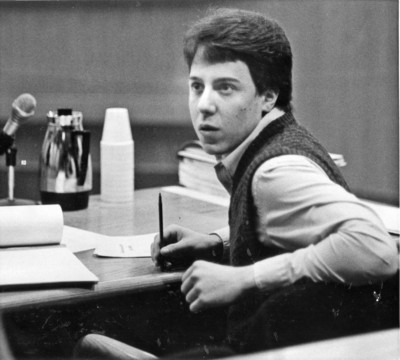Convict Scott Sloane hopes DNA evidence clears him in 1984 slaying
Twenty-four years ago, a boyish-looking teen stood in a Las Vegas courtroom, stunned after a jury had just convicted him of killing a Saks Fifth Avenue cosmetics saleswoman in one of the most notorious rape and murders in Las Vegas.
"I didn't expect things to go this way," Scott Sloane told the jury in disbelief. "I honestly thought my attorneys showed you people... that it couldn't have been me."
Sloane, 16 at the time of the killing, was given five back-to-back life sentences. Now 41, he maintains his innocence from his cell at the maximum security Ely State Prison.
He is hoping DNA evidence will set him free.
Sloane's conviction in the sexual assault and murder of Nancy Menke, a mother of four, is now under review. The Rocky Mountain Innocence Center, a nonprofit, Utah-based group, has taken up his case.
Randall Edwards, a private attorney hired by the center to represent Sloane, asked Las Vegas authorities last year to conduct DNA testing on crime scene evidence, including hairs, body fluids and Menke's panties.
District Judge James Bixler approved the request in May. Prosecutors coordinated the tests. The Metropolitan Police Department's crime lab is conducting the tests and results are expected back in several weeks.
Katie Monroe, executive director of the Innocence Center, said Sloane contacted the center through letters. The group decided to take his case after an initial investigation.
"I've worked a lot of innocence cases," she said. "He sounds like an innocent person."
Authorities have long believed there were two people involved in Menke's rape and murder, because more than one blood type was found in her. One matched Sloane's type, but one remains unidentified, authorities said.
But the blood tests conducted at the time weren't nearly as precise as today's DNA testing, a tool now wielded by both law enforcement and the accused.
Forty-four states and Washington, D.C., now have laws granting the convicted various levels of access to DNA testing, according to the New York-based Innocence Project, a nonprofit that works to exonerate prisoners using DNA evidence.
In Nevada, authorities are required to test DNA evidence for anyone sentenced to death. A proposal now before the Legislature, Assembly Bill 279, would extend mandatory DNA testing to all those convicted of murder or felony sexual assault.
"The purpose of DNA isn't just to find the guilty party, but also to ensure that the innocent aren't detained," said Assemblyman Bernie Anderson, D-Sparks, the bill's sponsor.
Nevada is one of 16 states without a well-known case of DNA exoneration.
But DNA testing may produce more questions than answers in Sloane's case. No one knows how well the case evidence has been preserved after more than two decades. There's a chance that the results won't be conclusive. Or the results could confirm Sloane's guilt.
Even if the crime scene DNA doesn't match Sloane, there remains the other evidence authorities used to convict him. The gun used on Menke was registered to Sloane's mother. A witness saw Sloane covered in blood and acting wildly the night of the murder.
Very little stood out about Sloane before the slaying. A student at Chaparral High School, he was described as a "C" student who wasn't too interested in school. He was considered friendly but generally kept to himself.
His mother, Robin Sloane, told a jury that Sloane helped care for his mentally retarded sister, often did household chores and even painted the family's home when he was 14. Sloane was working at a pizza restaurant at the time of his arrest.
Bruce Menke, Nancy Menke's son, learned that authorities were reopening the case last summer. He sat through every day of Sloane's 1985 trial and believes authorities imprisoned the right man.
"I believe that he is guilty," Menke said by telephone from his ranch in Texas. "If you look at the record, I don't see how you come away with a possible explanation that he isn't responsible."
INNOCENCE PROJECT
DNA evidence has exonerated 235 people across the country since 1989, according to the Innocence Project. These, however, are the success stories.
Eric Ferrero, the group's communications director, said the Innocence Project has sought DNA testing in thousands of cases. Often, the evidence can't be found or DNA tests prove inconclusive.
Many people have a general idea of what DNA testing is because of paternity testing, where the result is a simple yes or no, he said. But findings aren't as clear in criminal cases that are sometimes decades old.
The work of the Rocky Mountain Innocence Center, which has only three prior cases under its belt, has produced mixed results. The center helped a Utah man convicted of rape and murder, Bruce Dallas Goodman, win an exoneration through DNA testing. In another case, testing was inconclusive. Results in the third case implicated the prisoner.
VICTIM HANDCUFFED
Nancy Menke went missing on March 20, 1984.
Menke, 41, left her job at Saks Fifth Avenue and drove to the Boulevard Mall to buy athletic shoes for her daughter. When she didn't arrive home, her husband, Norman, a lieutenant colonel stationed at Nellis Air Force Base, searched for her. He reported her missing to police when he couldn't find her.
Her body was found the next day in the passenger seat of her Honda Accord in a desert area near Harmon Avenue and Lamb Boulevard.
Menke's arms were handcuffed behind her back. A pair of pantyhose -- not hers -- was wrapped around her neck. She had been raped, strangled and beaten with a large rock. She also had been shot in the head six times with a .25-caliber gun.
Police believe her assailant or assailants had abducted her from the Boulevard Mall parking lot.
Las Vegas police had no initial suspects. But six months after Menke was killed, a crime scene analyst came across a robbery report made by Sloane. He claimed that two men abducted him from Boulevard Mall the same night Menke disappeared.
Sloane told police that two assailants forced him into his car and made him drive to an area about a half-mile from where Menke was found.
The men pushed him out of the car and fled in a separate vehicle, he told police.
Police didn't believe his story and began investigating Sloane.
They discovered his connection to the gun. The handcuffs used to bind the victim were believed to have been stolen from a grocery store where Sloane had been a box boy.
Sloane's neighbor, Laurie Martin, told police he came to her house the night Menke was killed. Sloane was drenched in sweat, his face and arms smeared with blood.
Martin said Sloane seemed nervous but didn't appear to be injured.
"It was kind of like a euphoric state," Martin testified at trial. "I'd never seen anything like it."
Las Vegas police arrested Sloane on Oct. 9, 1984, and charged him with Menke's rape and murder.
But even after the arrest, authorities believed Sloane had an accomplice. There was an excessive amount of semen found during Menke's autopsy. And the crime itself was so brutal that it seemed unlikely a 16-year-old with no violent criminal history would execute it on his own.
CONTRADICTORY EVIDENCE
Sloane's trial began in early August 1985. One of his attorneys, Stephen Dahl, is now a North Las Vegas justice of the peace.
"At times he was quiet. He could be happy. Kind of what I would expect from a 16- or 17-year-old kid accused of murder," Dahl said recently.
Dahl has had no contact with Sloane since the trial, which lasted almost three weeks.
Many pieces of evidence against Sloane were met with equally contradictory evidence from his defense.
Sloane's longtime friend, Larry Hart, told the jury that Sloane offered him a $5,000 bribe to recant damning statements he made to police.
Hart said Sloane told him he had taken a pair of handcuffs from the Smith's grocery store where the two worked together, according to news accounts of the trial.
Those cuffs were believed to be the ones used on Menke.
However, a fingerprint examiner for the Las Vegas police testified that none of the latent prints in Menke's car belonged to Sloane.
According to a Las Vegas police report from 1984, police found blood type A, B, or AB in Menke.
A police criminologist later told the jury that Sloane's blood type, A, was present in the semen found in Menke. But there were two other blood types discovered. One belonged to Menke.
But the criminologist suspected a second suspect was involved because blood type B also was present in the semen.
The criminologist testified it would be unlikely that there was only one assailant, someone with blood type AB, because that blood type is found in only 4 percent of the population.
There also was information attorneys didn't tell the jury.
During the trial, prosecutors and defense attorneys met with presiding Judge Miriam Shearing in her chambers. According to a transcript, then-Chief Deputy District Attorney Dan Seaton told the judge that Sloane rarely spoke about girls his own age.
Sloane "had a thing for older women," Seaton said in the transcript.
Sloane told friends that he was attracted to Martin, the neighbor who testified against him. Seaton said Sloane's father also had set him up with older women in California.
The jury deliberated for about 17 hours before finding Sloane guilty of first-degree murder, first-degree kidnapping and sexual assault.
Jurors sentenced him to five life terms.
Seaton, now in his 70s, retired in 1999. He still remembers Sloane as one of the highest-profile cases of his 27-year career with the district attorney's office.
Seaton said he wasn't surprised the case was being reopened, considering the advances in DNA testing. He also said he never doubted that Sloane was guilty.
"I'm sure Scotty committed this crime," he said. "I've never convicted someone whose guilt I doubted later on. The evidence is just too overwhelming."
Contact reporter David Kihara at dkihara @reviewjournal.com or 702-380-1039.





















